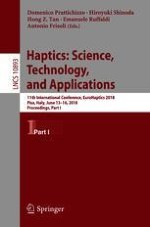2018 | OriginalPaper | Buchkapitel
Haptic Saliency Model for Rigid Textured Surfaces
verfasst von : Anna Metzger, Matteo Toscani, Matteo Valsecchi, Knut Drewing
Erschienen in: Haptics: Science, Technology, and Applications
Aktivieren Sie unsere intelligente Suche, um passende Fachinhalte oder Patente zu finden.
Wählen Sie Textabschnitte aus um mit Künstlicher Intelligenz passenden Patente zu finden. powered by
Markieren Sie Textabschnitte, um KI-gestützt weitere passende Inhalte zu finden. powered by
